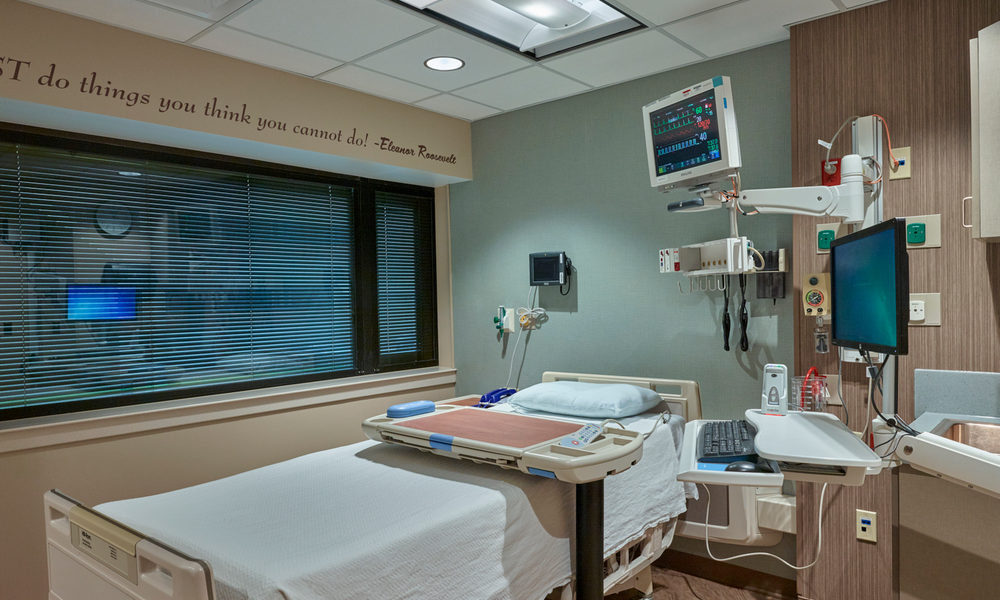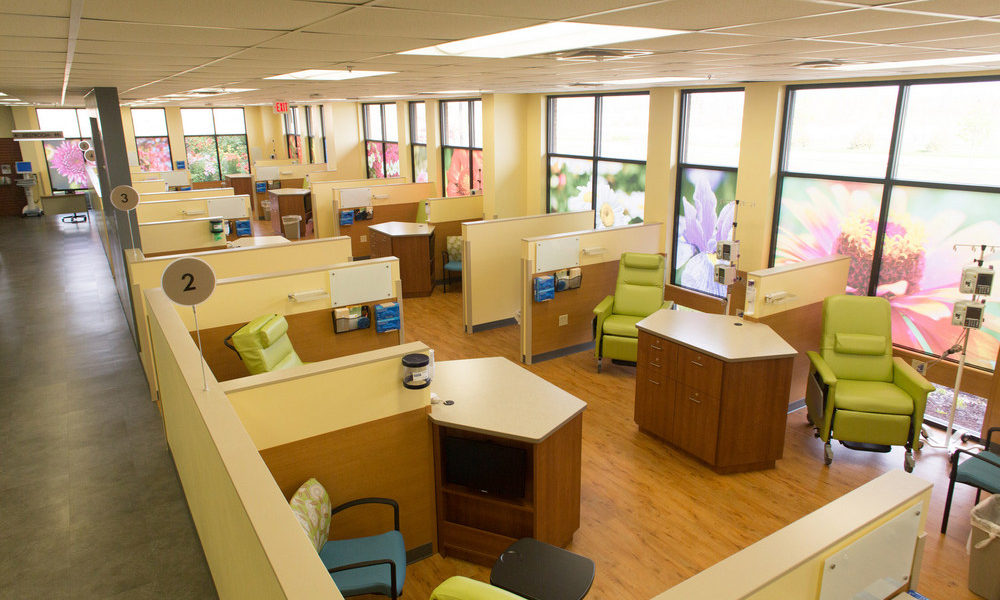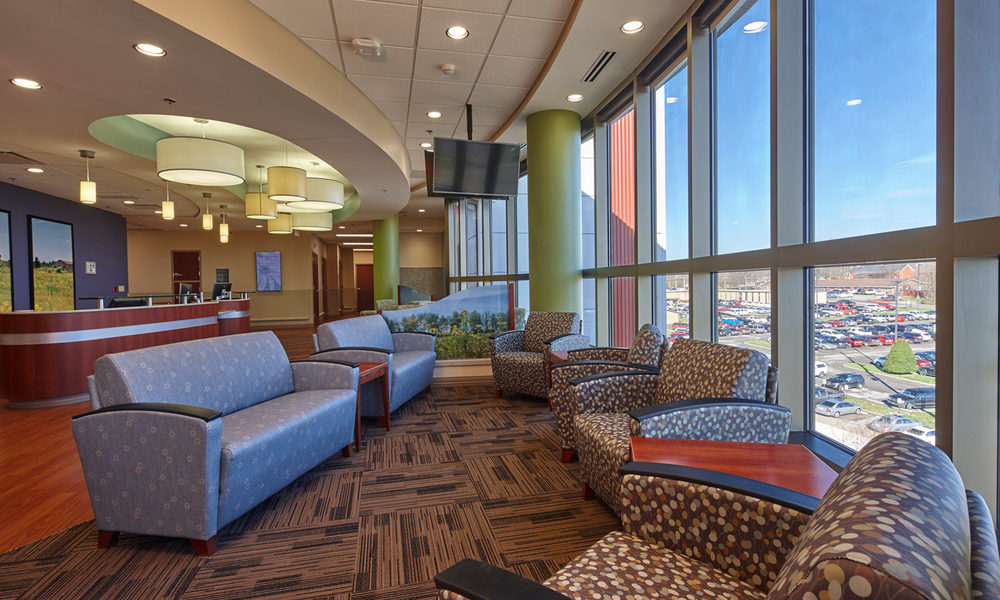 Patient room with integral shades.
Patient room with integral shades.  Nature images on windows of cancer infusion clinic windows.
Nature images on windows of cancer infusion clinic windows.  Side lighting brightens hospital waiting area.
Side lighting brightens hospital waiting area. Subscribe Now
Daylighting Materials + ‘New Norm’ for Healthcare Infection Control
By Mark Trier
Proper daylighting is a fundamental component in all great buildings. It offers a window to the exterior, increases occupant productivity and, if done properly, reduces building energy and operational costs. Studies have shown that healthcare occupancies benefit from great daylighting through decreased lengths of patient stays and more productive staff. These benefits have resulted in recommended requirements for daylighting in various patient areas by the FGI Guidelines for Design and Construction.
However, with the COVID-19 pandemic, every area of our lives is being evaluated so we can create the “new norm.” From travel to recreation to how we work, the virus has forced a close examination of daily hygiene habits, increased dependence on video conference call technology and established social-distance limitations. Fortunately, the healthcare world has strived to reduce the spread of deadly pathogens long before the novel coronavirus changed our lives. With this emphasis on infection control in all building types, the construction world is fast-forwarding research into new methods and materials to respond to the challenge. This following examines the fundamentals of daylighting components, and details current and proposed technologies that assist in the prevention of infections in healthcare occupancies.
Daylighting methods can be divided into side-lighting and top-lighting systems. Patient rooms typically use side-lighting devices, such as windows to meet the FGI guidelines. Larger gathering spaces, such as common rooms in behavioral health suites and major corridors, use top lighting provided by skylights or tubular daylighting devices. They offer a pleasant and uplifting environment to counteract the typically dense volumes of hospitals and medical office complexes. Both systems have the following components: framing, glazing and shading. Now, let’s take a look at how these components combat airborne pathogens:
Framing components: Windows, clerestories and skylight frames are typically made of aluminum with either an anodized or painted finish. This metal has a dense surface with very little porosity and does not rust like glazing frames made of steel. If frames were available in a copper alloy like what is used for healthcare-grade door hardware or plumbing fixtures, the antimicrobial properties are documented to kill 99.9% of the pathogens that cause infections within two hours. However, copper alloy is an expensive material. Today, it is used in hospitals in their cancer infusion centers and bone marrow intensive care units, but is generally cost prohibitive for use in all areas of the hospital. Although the copper alloy is advanced technology, its cost-prohibitive nature will not make it feasible for use as window frame material in the near term.
A more promising technology the healthcare industry has already implemented is microbiocidal paint and coatings. According to product manufacturers, these products will kill 99.9% of dangerous bacteria strains within two hours of contact on a surface coated with this product. It has been on the market for several years and I have used it successfully on walls and ferrous door frames at an emergency department in Kentucky. As of this date, the manufacturer has not tested the paint’s capabilities to destroy the novel coronavirus. If it proves to be effective, it can be expected to be the “go-to” paint for walls and door frames for every place we work, play and live. In addition, it is not unreasonable to expect this cutting-edge technology will eventually be available in a product that can be applied to glazing framing components. Until then, it is important to use CDC-recommended topical disinfection treatments to clean window frames.
Glazing components: Glazing components can be divided into glass and polycarbonate panels. For the purposes of this article, we will only discuss glass because of this material’s longevity, strength and low rate of expansion. Insulated glass is required by today’s energy codes. In addition, various tints and coatings are also critical to meet U.S. Department of Energy COMcheck criteria. These materials block a high percentage of ultraviolet radiation, a proven technology used to kill or deactivate pathogens. UV radiation, however, can be artificially produced inside the building in carefully placed locations. A time-tested way to utilize its killing power is to add ultraviolet germicidal irradiation units to the inside of the buildings’ air handler system, a common practice in sterile healthcare spaces, such as operating rooms or bone marrow transplant units. While we have noted an increased use of these units in other healthcare spaces, we are also seeing UVGI units installed in air handler units in schools. This device adds 10-15% to the initial AHU cost — a reasonable expenditure to combat viruses. In summary, coated-insulated glass will continue to be specified to block the sun’s UV rays and improve the energy efficiency of buildings. However, adding UVGI units to the air system provides an effective way to radiate airborne pathogens.
Shading components: Private-patient rooms typically have shades to control sunlight entering the space and errant night lights that distract patient sleeping. These have been produced with antimicrobial materials for several years. They have synthetic fibers that withstand robust cleaning agents used in today’s healthcare institutions. Unfortunately, daily surface disinfection is needed to clean these devices. On the other hand, integral blinds within the insulated glazing systems eliminate this special cleaning, while continuing to provide light control. These systems will become more cost effective as part of the “new norm.”
Other popular internal shading devices are etched patterns and films applied to the glass. Etched patterns are available in a variety of styles, with a small dot matrix or linear pattern being the most prevalent. These patterns also qualify as “bird safe glass” for multistory projects. Film applied to the interior surface of the insulated glass is another less expensive option. Innovative ideas include nature pictures that are applied as a film on the glass surface. These pictures provide a colorful art glass environment in waiting rooms or cancer infusion clinics.
Healthcare institutions have been diligent in their continued research for the best building materials to combat infection. Some of these highly specialized products are now specified by architects and engineers for other building types. It is predicted that eventually costs will be lowered due to their mass production. Bottom line: the new focus on infection-killing materials created by the COVID-19 pandemic will serve to revolutionize building technology as part of the new norm.
Photos courtesy of JRA Architects.
Author: Mark Trier
Mark Trier, AIA, LEED AP, has been a registered architect for 37 years. He is past president of JRA Architects.
Tags: Architecture, COVID-19, daylighting, FGI Guidelines, infection control, U.S. Department of Energy
Posted July 13, 2020
More Articles:
- CxA Workshop & Exam
Apr 29, 2024 – Apr 30, 2024 - EMP Seminar & Exam at CxEnergy 2024
Apr 29, 2024 – Apr 30, 2024 - CxEnergy
Apr 29, 2024 – May 2, 2024 - PHCC West 2024
Apr 29, 2024 – May 2, 2024 - Lean in Design Forum 2024
May 1, 2024 – May 2, 2024 - IFMA’s Facility Fusion Conference & Expo
May 5, 2024 – May 7, 2024 - ASHE Academy 2024
May 6, 2024 – May 10, 2024










